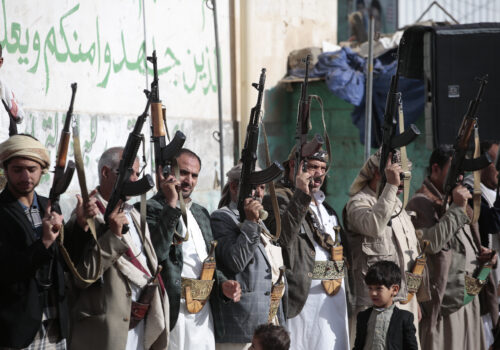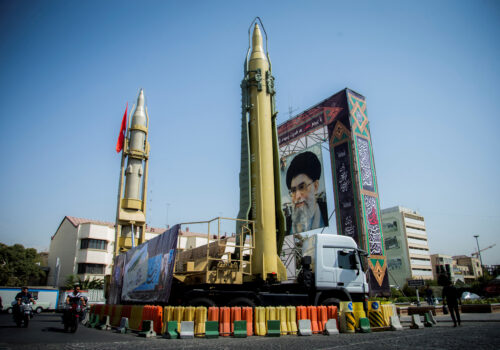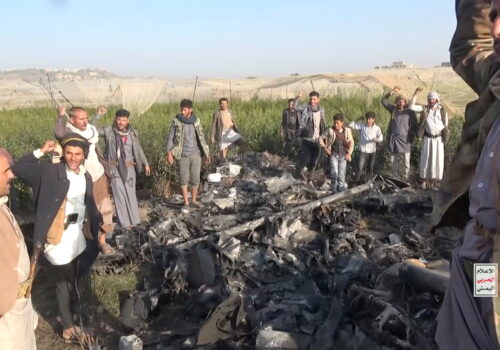Trump’s military cudgel in Yemen will not achieve US regional objectives
On 15 March, US President Donald Trump announced a series of strikes on targets associated with the Yemeni Islamist group Ansar Allah—led by the Houthi family—in the most significant military operation of his second term so far. The strikes may be only the start of a campaign against the Houthis. They follow one of the less publicized moves from Trump’s first week back in office, when he re-designated Yemen’s Ansar Allah as a “foreign terrorist organization”(FTO) over its Gaza war-related attacks on Israel and shipping in the Red Sea. “The Houthis’ activities threaten the security of American civilians and personnel in the Middle East, the safety of our closest regional partners, and the stability of global maritime trade,” the White House order said.
But the Trump administration risks falling into a US pattern dating back to the post-9/11 Global War on Terrorism, opting for short-sighted military action at the expense of constructing a sustainable plan for Yemen. Multiple US administrations have neglected the conflict’s complexities, leading to failure in executing an enduring strategy that protects Washington’s interests in Yemen and the wider region. Yemen’s many overlapping conflicts and dire humanitarian conditions will not be resolved by US military action, which will likely further institutionalize war, weapons flows, foreign interference, fragmentation, weak governance, and humanitarian catastrophe.
Origins of Yemen’s conflict
The Republic of Yemen—created in 1990 via the merging of the tribal northern Yemen Arab Republic and the Marxist southern People’s Democratic Republic of Yemen—has never been a unitary country, society, or people. Despite its long history, predating the 7th-century revelation of Islam by some two millennia, Yemen has rarely been governed by a single political authority. Even before civil war broke out between the internationally recognized—and Saudi-backed—Yemeni government and Ansar Allah (Partisans of God) in 2014, Yemen was plagued by chronic violence, insecurity, and poverty. The Iran-supported Houthis are only one of many challenges to regional security that emerge from Yemen to defy the US vision of a peaceful, productive, and integrated Middle East. Other challenges include franchises of the two most violent Sunni extremist groups, Al-Qaeda and the Islamic State, as well as a variety of other armed groups fighting within Yemen in an effort to shape its uncertain future. The Republic of Yemen government in Sana’a had only tenuous control over many parts of the country that are under the sway of tribal groups or other armed elements, including secessionists, terrorists, and religious extremists.
Nonetheless, Ansar Allah, which emerged in the 1990s, remains the most persistent threat in the region. It was a thorn in the side of the Sana’a government, fighting no less than six wars against the regime of former President Ali Abdullah Saleh. When Saleh stepped down after the 2011 Arab Spring uprising in Yemen, Ansar Allah’s Houthi leaders made their bid for political power. In 2015, they forced Saleh’s successor, Abd-Rabbu Mansour Hadi, first out of Sana’a and later into exile in Saudi Arabia. The current Yemeni Presidential Leadership Council—Hadi’s ostensible successor—still operates out of Riyadh. The Houthis continue to play a central role in Yemen’s ongoing conflicts and have expanded their attacks beyond Yemen, as Trump noted. The 2023 edition of the US State Department’s Country Reports on Terrorism reported that the Yemeni government “controlled about two-thirds of Yemen’s territory, but between 60 percent and 70 percent of the country’s population lived in Houthi-controlled areas.”
Regional consequences
Yemen—forming one side of the Bab el-Mandeb strait—is a highly strategic ground overlooking the entry/exit point of the Red Sea, which facilitates the Houthi attacks against global shipping routes. Further, the multitude of conflicts and armed actors are threatening neighbors, like Saudi Arabia and the United Arab Emirates (UAE), contributing to the Houthis’ gaining Iranian support in 2012. As Asher Orkaby noted, “Yemen’s instability is simultaneously a threat to Saudi Arabia and a source of potential strategic benefit to Iran.” Ansar Allaheven collaborated closely with Lebanese Hezbollah to refine its military and governance structures. Consequently, with US assistance, the Arabian Peninsula powers intervened to shape the Yemeni battlefield in their favor. Further, its attacks against Israel, in solidarity with the Palestinians in Gaza, have elicited Israeli retaliation, as its attacks on Red Sea shipping have elicited US retaliation. US competitors, Russia and China, have also begun taking advantage of the openings the various Yemeni conflicts present.
In 2015, Saudi Arabia launched an aerial assault on northern Yemen with as much as $200 million per day in weapons expenditure. The UAE also intervened in Yemen, seeking to overturn Houthi rule by sponsoring anti-Houthi militias. Consequently, Yemeni civilians—victimized by the overlapping conflicts—are paying a staggering humanitarian price. Seeking to end the war’s negative consequences in 2021, then-President Joe Biden announced an end to US support for Saudi Arabia’s air campaign, declaring that “this war has to end.”
The negative impact of international military intervention in Yemen is exemplified by the Southern Transitional Council, a separatist movement backed by the UAE. Although the group has often clashed with other Yemeni militias, in 2023, it joined other southern factions in calling for the restoration of South Yemen with its pre-1990 borders, a clear sign that actors like the UAE will pursue their own interests at the expense of a unified Yemeni state. The UAE also supports a western Yemeni group known as the Joint Forces, led by a nephew of former President Saleh, which also skirmishes with the Houthis.
SIGN UP FOR THIS WEEK IN THE MIDEAST NEWSLETTER
By November 2024, the Houthis were also receiving extensive support from Russia, “which apparently sees the Yemeni group as an instrument through which to retaliate for and deter Western support for Ukraine.” A Wall Street Journal report in October revealed that the Kremlin provided the Houthis with targeting data for its strikes against commercial shipping in the Red Sea—perhaps in exchange for free passage for Russian vessels, as well as Yemeni youth, to serve as cannon fodder in Russia’s war in Ukraine. China has also provided the Houthis with missiles in exchange for leaving its ships alone. The Houthis have also sought to establish warmer relations with Sunni jihadist groups, including their Yemeni rival al-Qaeda in the Arabian Peninsula and al-Shabaab in Somalia, alliances that help the Houthis tighten their stranglehold on the Bab al-Mandeb.
The toxic mix of factional violence, weak governance, and external powers interfering to protect their geopolitical interests has led to overwhelming humanitarian costs in Yemen. Indeed, upwards of 60% of the more than 377,000 people who have perished in the conflict died from non-military causes, according to the United Nations. An additional four and a half million are internally displaced, and 18.2 million depend on humanitarian assistance, according to the UN Refugee Agency, aid which has been scaled back in the past couple of years. Moreover, the designation of Ansar Allah as an FTO requires a review of US assistance programs in Yemen and directs the termination of projects, grants, and contracts with entities found to have made payments to Houthi entities or to have insufficiently documented Houthi abuses.
Inadequate US strategy
The US military approach in Yemen is essentially a two-pronged strategy: seeking to degrade terrorist external operations while strengthening local capacity to tackle destabilizing insurgencies.
First, the US has relied heavily on its drone program for tactical counterterrorism missions in Yemen, launching over three hundred drone strikes in an effort to keep al-Qaeda in the Arabian Peninsula (AQAP) at bay. These strikes have killed up to 150 civilians and over one thousand confirmed militants, according to one monitor. The drone strike program has proven effective at countering international terrorism but less effective at resolving insurgencies in target countries. Alternatives to the drone program pose different risks; in the January 2017 Yakla raid, for example, when a joint US-UAE special operations raid attempted to capture AQAP leader Qasim al-Raymi, between ten and thirty civilians were killed in the raid, including an American citizen, as well as several AQAP fighters and Navy SEAL William Owens. Al-Raymi was not found but would later be killed in a US airstrike.
The second prong of this strategy has involved support to local actors, primarily the Yemeni government, to strengthen their capacity to conduct counterterrorism. According to the Security Assistance Monitor, this support for Yemen topped $850 million. While preventing the US military from being forced to deploy to Yemen, the approach made support contingent on counterterrorism successes, not much-needed reforms. “This approach tends to undermine the political and social alternatives that foster better governance and political participation,” former Yemeni diplomat Mustafa Naji wrote, criticizing the strategy. “In Yemen specifically, the American approach prioritized combating terrorism and piracy in the Gulf of Aden… but…overlooked the priorities of the people on the ground.” Ultimately, it proved relatively ineffective. The State Department’s most recent Country Report on Terrorism notes that the Yemeni government “cooperated with the US government on counterterrorism efforts but could not fully enforce [counter-terrorism] measures or consistently lead multilateral efforts because of instability, violence, and degraded capabilities.”
The attacks against the Houthis and their designation as an FTO may damage the group but will not help Yemen’s political leaders build consensus. As Peter Salisbury and Michael Wahid Hanna wrote in Foreign Policy “designations deepen political polarization, foster incentives for non-designated groups to pursue maximalist demands, and make third-party mediation, vital to resolving conflicts through political settlements, harder at times by criminalizing even limited contact with designated groups.”
Yemen is now effectively a failed state where the causes and potential solutions of conflict are immensely complex, and those complexities have frustrated US policymakers and sent the country to the bottom rung of America’s foreign policy priorities. The civil war provides the backdrop for Yemen’s many plagues—seemingly irreconcilable opponents, weak governance, terrorism, external interference, and a humanitarian crisis—each of which poses major threats to its stability and ensures it will likely remain a significant challenge for Western and regional policymakers.
Indeed, the conflict in Yemen has thrived in large part because of US and other Western ignorance and missteps. As Allison Minor wrote for the Brookings Institution last year, the failure to prevent war was in large part due to “Insufficient high-level attention and bandwidth dedicated to Yemen even during periods of crisis… undermining decisive US policy action.” For Trump, his transactional approach to solving problems may be frustrated by actors who are benefitting from the status quo, many of which are beyond US influence.
Although the front lines of Yemen’s conflict are “frozen,” according to several monitors, the deadlock is leading to an awkward, if informal, partition—a north governed by the Houthis and a south governed by secessionist elements who oppose them. However, as Gregory Johnsen notes, partition wouldn’t “be the end of the war in the South. Instead, in all likelihood, it will spawn a new round of fighting.” Hans Grundberg, the UN Special Envoy of the Secretary-General for Yemen, said in July that “The only way to move forward in Yemen is to find mutually acceptable solutions through dialogue and negotiation.” While that prospect is easier said than done, the United States is not even engaged in such an effort. In fact, US Secretary of Defense Pete Hegseth has made clear that his concerns about the Yemeni conflict only extend to countering threats to Washington’s interests in the region. As he put it in last weekend’s appearance on Fox News, “we don’t care what happens in the Yemeni civil war.”
Jacob Ware is a research fellow at the Council on Foreign Relations, an adjunct professor at Georgetown University and DeSales University, and the co-author of God, Guns, and Sedition: Far-Right Terrorism in America.
Amir Asmar is a non-resident Senior Fellow at the Scowcroft Middle East Security Initiative at the Atlantic Council and an adjunct professor of Middle East geopolitical issues at the National Intelligence University. He was previously a senior executive and Middle East and terrorism analyst in the US Department of Defense.
The views expressed are the authors’ and do not imply endorsement from the Office of the Director of National Intelligence or any other US Government agency.
Further reading
Fri, Mar 14, 2025
The United States’ Houthi terrorist designation unmasks Russia’s Yemen strategy
MENASource By
Yemen's Houthi rebels have become a tool of foreign powers, shifting from an Iran proxy to a Russian asset.
Tue, Mar 4, 2025
The stage is set for a US-Iran showdown—not a deal
MENASource By
Right now, signs indicate that the United States and Iran are headed towards confrontation, not a successful diplomatic outcome.
Wed, Feb 26, 2025
How the Houthis’ strikes on US MQ-9 Reaper drones serve a wider regional agenda
MENASource By
The United States needs to adjust its drone deployment strategy to ensure that MQ-9 Reapers are less vulnerable to the militant group’s attacks.
Image: A ship fires missiles at an undisclosed location, after U.S. President Donald Trump launched military strikes against Yemen's Iran-aligned Houthis on Saturday over the group's attacks against Red Sea shipping, in this screengrab obtained from a handout video released on March 15, 2025. U.S. Central Command/Handout via REUTERS THIS IMAGE HAS BEEN SUPPLIED BY A THIRD PARTY


